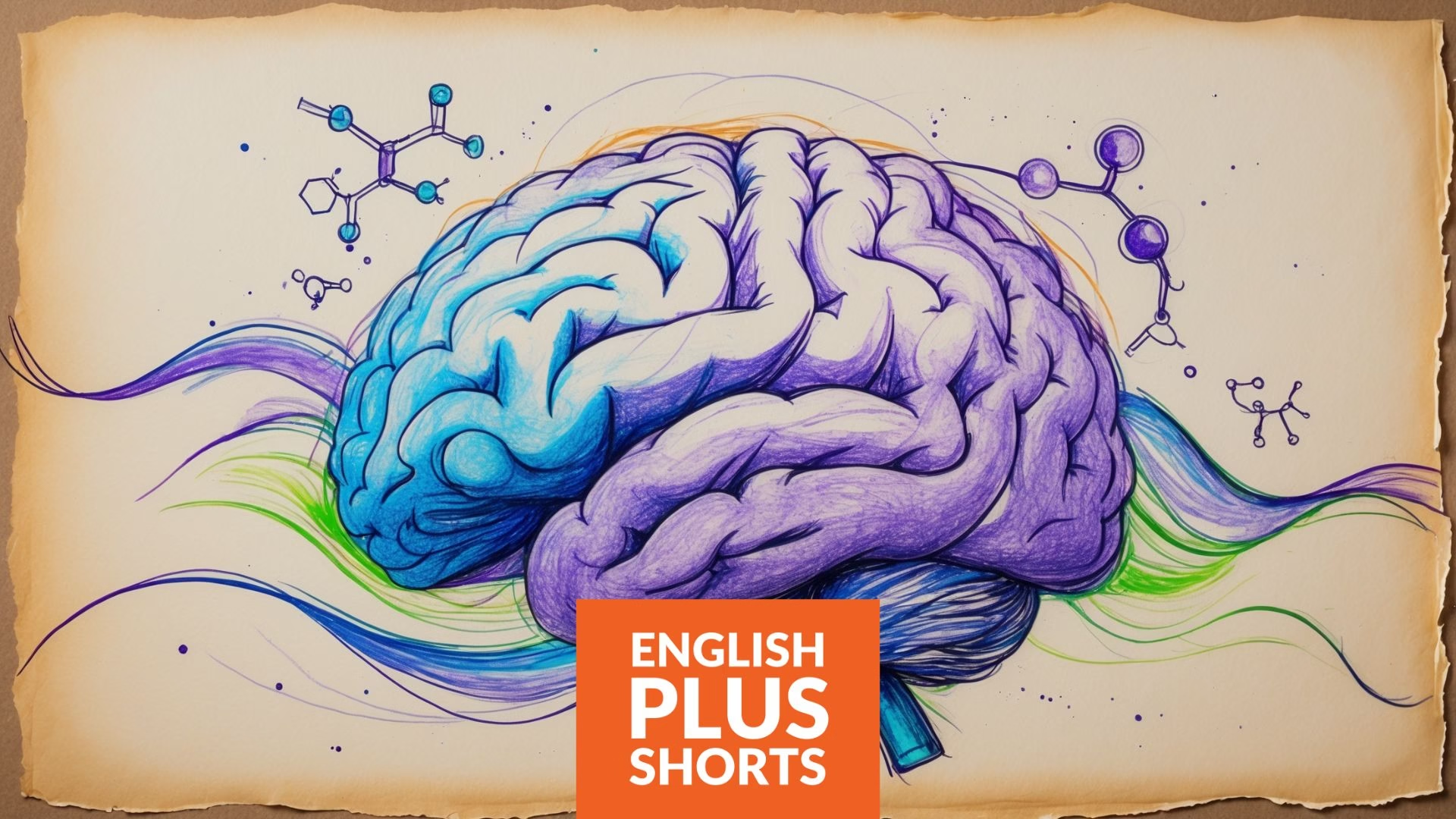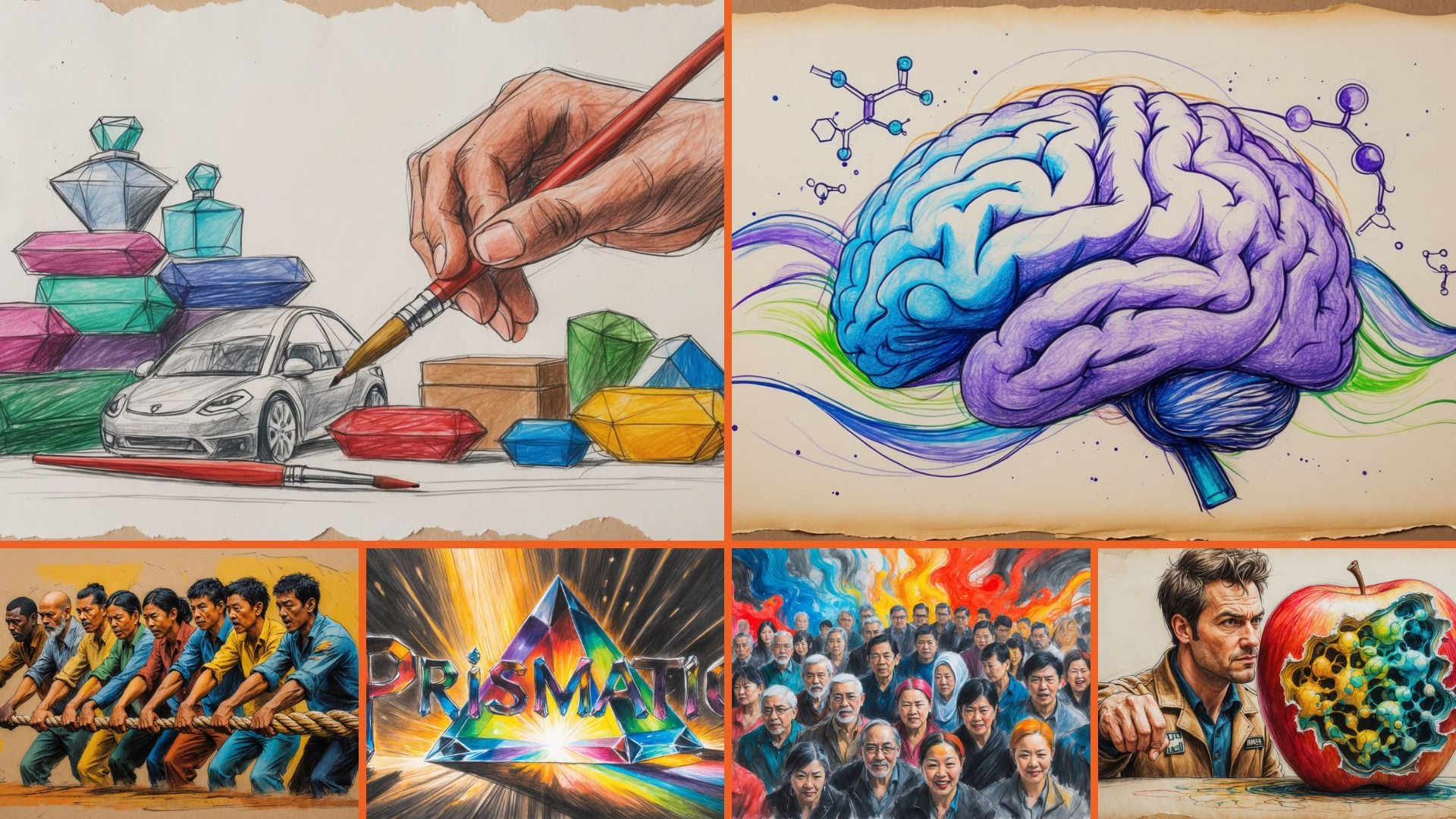- Podcast Episode
- Daily Expression | Pull One’s Weight
- Daily Question | If You Had to Sacrifice One Luxury in Order to Pursue a Passion, Which One Would It Be?
- Daily What If | What If Emotions Were Visible as Colors?
- Word of the Day | Prismatic
- MythBuster | Organic Materials Don’t Contain Chemicals
- Science Sparks | The Science of Anesthesia
Podcast Episode
Daily Expression | Pull One’s Weight

Have you ever been part of a team, whether it’s at work, in a group project, or even just helping out with chores at home, and you felt like you were doing most of the work while others weren’t contributing as much? Well, that feeling often leads to the expression we’re diving into today: “pull one’s weight.”
Isn’t it a straightforward image? Imagine a group of people pulling on a rope together. If everyone is putting in effort, the task gets done efficiently. But if some people are just holding on without really pulling, then the others have to work harder to compensate. That’s the essence of “pulling your weight.”
So, what does it really mean to “pull one’s weight”? It means to do your fair share of the work or to contribute equally to a common task or goal. It implies a sense of responsibility and a commitment to not relying on others to carry the burden.
Where does this expression come from? It likely originates from the literal act of pulling something heavy, like a boat or a cart, where the effort needs to be distributed evenly among those involved. If someone isn’t “pulling their weight,” the task becomes much harder for everyone else.
Think about some common situations where you might hear this expression. In a workplace, if one team member consistently misses deadlines or doesn’t contribute their fair share to projects, their colleagues might say they’re not pulling their weight. In a family, if one person leaves all the housework to others, they might be told to start pulling their weight.
We’ve all probably experienced situations where we felt like we were pulling more weight than others, and perhaps there have been times when we ourselves might have been perceived as not contributing enough, maybe unintentionally.
The power of this expression lies in its directness. It clearly communicates the idea of shared responsibility and the importance of everyone contributing their fair amount. It highlights the potential for resentment and frustration when that balance isn’t maintained.
But let’s delve deeper into what “pulling your weight” really means in our lives. I think it goes beyond just the tangible tasks we perform. It also encompasses our attitude, our willingness to help, and our overall contribution to the team dynamic.
Someone might be completing their assigned tasks, but if they have a negative attitude or are unwilling to help others, are they truly pulling their weight? Similarly, someone might not be the most skilled at a particular task, but if they’re enthusiastic, willing to learn, and always offer their support, their contribution might be just as valuable.
Consider the impact of someone not pulling their weight on a team or a group. It can lead to increased stress and workload for others, resentment and frustration, and ultimately, a decrease in overall productivity and morale. It can create an imbalance where some feel taken advantage of or unsupported.
And what about the person who isn’t pulling their weight? They might feel a sense of guilt or inadequacy, or they might be oblivious to the impact their lack of contribution is having on others. Sometimes, it might be due to a lack of skills or understanding, while other times it might be a lack of motivation or a feeling of entitlement.
Here’s a thought to ponder: What if we all took a moment to honestly assess whether we are truly pulling our weight in our various teams and relationships? Are we contributing our fair share? Are we supporting those around us?
Maybe it’s about being proactive, identifying areas where we can contribute more, and offering our help even when we’re not explicitly asked. It’s about taking ownership of our responsibilities and being mindful of the impact our actions (or inactions) have on others.
What if, instead of focusing on who isn’t pulling their weight, we focused on encouraging and supporting everyone to contribute their best? Maybe creating a more collaborative and supportive environment would naturally lead to everyone feeling more motivated to pull their weight.
So, the next time you’re working in a group, take a moment to reflect on the effort you’re putting in and the contributions of others. Are things feeling balanced? Is everyone pulling their weight? And if not, what can be done to create a more equitable and productive environment?
Now, I’d love to hear your thoughts on this. What if we lived in a world where everyone consistently pulled their weight, both in their personal and professional lives? What kind of positive impact would that have on our society as a whole? Share your experiences and insights with us in the comments section on the podcast, on our website englishpluspodcast.com, or on our Patreon page.
Daily Question | If You Had to Sacrifice One Luxury in Order to Pursue a Passion, Which One Would It Be?

Let’s ponder a question that might make you think about your priorities: If you had to sacrifice one luxury in order to pursue a passion, which one would it be?
We all have things in our lives that we consider luxuries – maybe it’s that daily gourmet coffee, the latest gadgets, frequent travel, designer clothes, or a fancy car. These are the things that often make life more comfortable and enjoyable, but are they essential to our happiness and fulfillment?
And then there are our passions – those activities or interests that truly ignite our soul, that make us feel alive and engaged. Maybe it’s painting, playing music, writing, starting a business, volunteering, or learning a new skill. Pursuing our passions can bring us immense joy and a sense of purpose, but sometimes it requires a significant investment of time, energy, and yes, sometimes even money.
So, imagine a scenario where you have a burning passion that you really want to pursue, but to do so, you have to give up one of your current luxuries. Which one would you be willing to sacrifice?
This question really forces us to consider what we value most. Are we more attached to our comforts and material possessions, or are we willing to make sacrifices in order to dedicate ourselves to something we truly love?
Let’s think about some of the potential luxuries you might have to choose from. Would you be willing to give up eating out at expensive restaurants in order to save money for art supplies or music lessons? Would you trade your annual overseas vacation for the time needed to write a novel or start a small business? Would you be okay with downgrading your car if it meant you could afford to volunteer for a cause you care about?
There are no right or wrong answers here, of course. What one person considers a luxury, another might see as a necessity. And what one person is passionate about might not resonate with someone else at all.
But the act of considering this question can be incredibly revealing. It can help us understand what truly motivates us and what we are willing to prioritize in our lives.
Think about the nature of luxury itself. Often, luxuries are things that provide us with comfort, convenience, or status. They can certainly enhance our lives, but are they ultimately essential for our well-being?
On the other hand, pursuing our passions can bring us a different kind of fulfillment – a sense of purpose, creativity, and deep satisfaction. It can connect us with others who share our interests and enrich our lives in ways that material possessions often cannot.
Consider the potential long-term benefits of pursuing a passion. While sacrificing a luxury might feel difficult in the short term, the joy and fulfillment that comes from engaging in something you love could have a much more lasting positive impact on your life.
Maybe the question isn’t just about giving something up, but about making a conscious choice to invest in something that truly matters to us. It’s about aligning our resources with our values and our aspirations.
What if the luxury you chose to sacrifice wasn’t a material thing, but something like free time spent on passive entertainment? Would you be willing to trade hours of watching television or scrolling through social media for dedicated time to work on your passion?
This highlights that the “luxury” we sacrifice doesn’t always have to cost money. Sometimes, it’s about reallocating our time and energy towards what truly brings us joy and satisfaction.
Think about the potential regrets we might have later in life. Would we regret not having that fancy car as much as we might regret not pursuing a lifelong dream or passion?
This question can help us gain clarity on our priorities and make choices that we are more likely to feel good about in the long run.
What if the act of sacrificing a luxury actually made the pursuit of your passion even more meaningful and rewarding? Perhaps the struggle and the conscious choice to give something up would deepen your commitment and appreciation for your passion.
I’d love to hear your thoughts on this. If you had to sacrifice one luxury in order to pursue a passion, which one would it be and why? Share your reflections with us in the comments section on the podcast, on our website englishpluspodcast.com, or on our Patreon page.
Daily What If | What If Emotions Were Visible as Colors?

Get ready for a world painted in feelings! Today’s “what if” scenario asks: What if our emotions were visible as colors? Imagine walking down the street and seeing a vibrant red aura around someone who’s angry, a sunny yellow glow around a happy person, or a deep blue hue surrounding someone feeling sad.
It’s a pretty wild concept, isn’t it? It would certainly change the way we interact with each other. We would have a constant, visual indicator of everyone’s emotional state. No more guessing games or trying to decipher subtle facial expressions – our feelings would be on full display for the world to see.
Think about the immediate implications. How would this affect our communication? Would we be more honest and upfront about how we’re feeling, knowing that everyone can see it anyway? Or would we try to control or mask our emotional colors?
Imagine a job interview where the interviewer has a faint green glow of envy while you’re talking about your accomplishments. Or a first date where your potential partner is radiating a bright pink aura of infatuation. It would certainly add a new layer of transparency to our interactions.
But what about the more complex emotions? Would there be a spectrum of colors for each feeling? Maybe a light yellow for contentment and a brilliant gold for pure joy. Or perhaps a dull grey for boredom and a stormy purple for anxiety. And what about mixed emotions? Would we see swirling patterns of different colors, reflecting the inner turmoil?
Consider the impact on society as a whole. Would it lead to more empathy and understanding? If we could literally see someone else’s pain or joy, would we be more inclined to offer support or share in their happiness? Or could it lead to more judgment and prejudice based on someone’s emotional state?
Imagine the challenges. What if you were trying to hide your anger in a professional setting, but your face was clearly radiating a fiery red? Or what if you were feeling deeply insecure, but your aura was a visible shade of grey, making you feel even more exposed?
And what about the potential for manipulation? Could people learn to control their emotional colors to deceive others? Maybe someone could project a calm blue aura while secretly harboring feelings of resentment.
Think about how this might affect our personal relationships. Would it make it easier to understand our loved ones’ needs and feelings? Or could it lead to more conflict if we constantly had a visual reminder of each other’s negative emotions?
Imagine a world where children’s emotions were particularly bright and volatile, like walking rainbows of pure feeling. It might make parenting a bit more visually chaotic, but perhaps also more intuitively understandable.
What about art and creativity? How would artists use this visible spectrum of emotions in their work? Imagine paintings that captured the swirling colors of a complex emotional landscape or music that evoked specific color palettes of feeling.
And what about our inner lives? Would being able to see our own emotions as colors give us a better understanding of ourselves? Could it help us identify patterns in our emotional states and learn to manage them more effectively?
Perhaps there would be a whole new language of emotions based on colors. We might talk about having a “blue day” or feeling “green with envy” in a much more literal sense.
What if, over time, we developed the ability to perceive even more subtle shades and hues of emotion, allowing for a much richer and more nuanced understanding of each other’s inner worlds?
This “what if” scenario really makes you think about the power of emotions and how much of our communication is non-verbal. If emotions were visible, it would certainly remove a lot of ambiguity, but it might also take away some of the mystery and complexity of human interaction.
I’d love to hear your thoughts on this. What if there were certain emotions that remained invisible, perhaps the most intimate or complex ones? Which emotions do you think should stay hidden, and why? Share your colorful ideas with us in the comments section on the podcast, on our website englishpluspodcast.com, or on our Patreon page.
Word of the Day | Prismatic

Let me ask you, have you ever held a prism up to the light and watched as it magically transforms a single beam into a dazzling rainbow of colors? That beautiful phenomenon is exactly what our word for today, “prismatic,” is all about.
Prismatic – say it with me: priz-MAT-ik. It’s a word that immediately evokes images of vibrant hues and the fascinating science of light. As an adjective, “prismatic” means relating to or having the properties of a prism, especially in producing a spectrum of colors. It can also be used more broadly to describe something that is full of a variety of bright colors or that has many different aspects or perspectives.
Where does this colorful word come from? It’s derived from the Greek word “prisma,” meaning “something sawed” (referring to the geometric shape of a prism). Over time, it came to be associated with the way a prism refracts light into its constituent colors.
When we use “prismatic” in its most literal sense, we’re talking about the way light is dispersed into a spectrum, like the colors of a rainbow – red, orange, yellow, green, blue, indigo, and violet. Think of sunlight passing through a crystal, or the way a droplet of water in the air can create a rainbow after a rain shower. These are all examples of the prismatic effect.
But the beauty of language is that words often extend beyond their literal meanings. “Prismatic” is also used metaphorically to describe things that have a wide range of qualities or perspectives. For example, you might say someone has a “prismatic personality” if they are multifaceted, with many different interests and talents. Or you could describe a complex issue as having “prismatic views,” meaning it can be looked at from many different angles.
Think about how you might use “prismatic” to add more color and vibrancy to your descriptions. Instead of saying “the light was colorful,” you could say “the light streaming through the stained-glass window cast a prismatic glow on the floor.” Doesn’t that paint a much more vivid picture?
Or imagine describing a piece of art that is full of different hues and shades. You could say it has a “prismatic quality,” suggesting a richness and variety of color that is almost dazzling.
What I love about the word “prismatic” is its inherent sense of beauty and wonder. It reminds us of the magic of light and the way it can be broken down into its component parts to create something truly spectacular.
Consider how the concept of “prismatic” can be applied to our own lives. Just like white light is made up of a spectrum of colors, our experiences and perspectives are often multifaceted and complex. We each have our own unique blend of qualities, beliefs, and experiences that make us who we are. In a way, each of us is “prismatic.”
What if we embraced the “prismatic” nature of our own lives and the lives of others? What if we recognized and appreciated the different perspectives and qualities that make the world such a rich and diverse place?
Think about a time when you encountered something that you would describe as “prismatic,” either literally or metaphorically. What made it stand out to you? What feelings did it evoke?
Maybe it was the way the light caught the facets of a gemstone, creating a dazzling display of color. Or perhaps it was a conversation with someone who offered a completely new and insightful perspective on a topic you thought you understood.
Here’s a thought to ponder: What if we tried to see the world and the people around us in a more “prismatic” way, appreciating the full spectrum of their qualities and perspectives, rather than just focusing on a single aspect?
So, the next time you see a rainbow, or light filtering through a prism, remember the word “prismatic.” Think about its literal meaning and its metaphorical applications. And consider how you might use this colorful word to add more depth and vibrancy to your own language.
What if understanding the “prismatic” nature of reality helped you to see more beauty and complexity in the world around you? Share your experiences with “prismatic” things or ideas with us in the comments section on the podcast, on our website englishpluspodcast.com, or on our Patreon page.
MythBuster | Organic Materials Don’t Contain Chemicals

Let’s tackle a common misconception that often pops up in conversations about food, products, and the environment: the idea that “organic” materials don’t contain chemicals. Now, if you’ve ever thought this, don’t worry, you’re not alone. But let’s put on our myth-busting hats and dive into the chemical truth of the matter.
So, the big question is: Is it true that organic materials are chemical-free? The short answer is a resounding NO! In fact, the very definition of “organic” in a scientific context is quite different from how it’s often used in marketing.
In chemistry, “organic” refers to compounds that contain carbon atoms covalently bonded to other atoms, typically hydrogen, oxygen, and nitrogen. This definition encompasses a vast array of substances, including everything from the food we eat to the clothes we wear, and yes, even those things labeled “organic.”
Think about it. What are living things made of? Plants, animals, us – we’re all composed of organic molecules. Carbohydrates, proteins, fats, DNA – these are all complex chemical compounds containing carbon. So, an organic apple, for example, is packed with chemicals like sugars (fructose, glucose, sucrose), acids (malic acid), vitamins (like ascorbic acid), and water (which, by the way, is also a chemical compound, H₂O!).
The term “organic” in the context of food and products usually refers to how these materials were produced. For instance, organic farming typically involves avoiding synthetic pesticides, herbicides, and fertilizers. It focuses on natural methods of cultivation. Similarly, organic products might be made with natural ingredients and without certain synthetic additives.
But this doesn’t mean that these organic items are devoid of chemicals. It simply means they were produced or made using methods that adhere to certain standards regarding the use of synthetic substances.
The misconception likely arises from the negative connotations sometimes associated with the word “chemical,” as if all chemicals are harmful or artificial. But the reality is that chemicals are the fundamental building blocks of everything around us, both natural and synthetic. Water is a chemical. Air is a mixture of chemicals. You are a walking, talking collection of incredibly complex organic chemicals!
Think about the language we use. We often talk about “natural” versus “chemical” as if they are mutually exclusive. But many natural substances are, in fact, complex chemical compounds. Essential oils, for example, are natural extracts from plants, but they contain a wide variety of organic chemicals that give them their scent and properties.
It’s important to understand this distinction because it helps us to approach information about products and food with a more critical eye. Just because something is labeled “organic” doesn’t automatically mean it’s inherently safer or healthier than something conventionally produced. It simply means it was produced according to a different set of guidelines.
And conversely, not all synthetic chemicals are harmful. Many are essential for modern life, from medicines that save lives to materials that make our technology possible. The key is to understand the specific chemicals involved and their potential effects.
What if we started thinking about “chemicals” in a more neutral way, recognizing them as the fundamental components of matter rather than automatically assuming they are harmful?
Consider the beauty and complexity of the natural world. It’s all chemistry in action! Photosynthesis, digestion, the changing colors of leaves in the fall – these are all intricate chemical processes.
So, the next time you see something labeled “organic,” remember that it’s still made of chemicals. The distinction lies in the source and the methods used to produce it. It’s about understanding the nuances of language and the underlying science.
What if we all embraced a little more scientific literacy and questioned the simple labels we often encounter? What kind of more informed decisions might we make about the products we use and the food we eat?
I’d love to hear your thoughts on this. Were you surprised to learn that organic materials contain chemicals? Share your reactions and any other common myths you’ve heard about “chemicals” with us in the comments section on the podcast, on our website englishpluspodcast.com, or on our Patreon page.
Science Sparks | The Science of Anesthesia

Have you ever had surgery or known someone who has? If so, you’re probably familiar with the incredible medical innovation that is anesthesia. It allows us to undergo painful procedures without feeling a thing. But have you ever stopped to think about the science behind this seemingly magical state? Let’s take a brief journey into the fascinating world of anesthesia.
Imagine a time before anesthesia. Surgery was a terrifying ordeal, often performed quickly and brutally, with patients fully conscious and experiencing excruciating pain. The development of anesthesia in the mid-19th century was a true game-changer, revolutionizing medicine and saving countless lives.
But how does it actually work? That’s where the science comes in. Anesthesia isn’t just about making you fall asleep. It’s a carefully controlled state that involves several key components: analgesia (pain relief), amnesia (loss of memory), immobility (muscle relaxation), and unconsciousness. The specific combination of these effects depends on the type of surgery and the individual patient.
There are two main types of anesthesia: general anesthesia and local anesthesia. Local anesthesia involves numbing a specific area of the body, allowing the patient to remain awake during the procedure. This is often used for minor surgeries or dental work. Local anesthetics work by blocking nerve signals in the targeted area, preventing pain signals from reaching the brain.
General anesthesia, on the other hand, induces a state of unconsciousness, so the patient is completely unaware of the surgery. This is typically used for more complex or invasive procedures. While the exact mechanisms of general anesthesia are still being studied, scientists believe it involves disrupting communication between different areas of the brain.
Several different types of drugs are used in general anesthesia, often in combination. These can include inhaled gases or intravenous medications. These drugs affect various neurotransmitter systems in the brain, leading to a loss of consciousness, muscle relaxation, and pain relief.
One of the fascinating aspects of anesthesia is how quickly it can take effect and how rapidly patients can recover afterwards. Anesthesiologists are highly trained medical professionals who carefully monitor patients throughout the entire process, adjusting the levels of anesthesia as needed to ensure their safety and comfort.
The development of anesthesia was a result of scientific curiosity and persistent experimentation. Early forms of anesthesia involved substances like nitrous oxide (laughing gas) and ether. While effective in reducing pain, these early anesthetics had significant side effects and were not always predictable.
Over time, scientists developed a better understanding of how these substances affected the body and brain, leading to the development of safer and more effective anesthetic drugs. Modern anesthesia is a highly sophisticated field, with a wide range of medications and techniques tailored to individual patient needs.
Think about the precision required to administer anesthesia. Anesthesiologists need to consider factors like the patient’s age, weight, medical history, and the type of surgery being performed to determine the appropriate drugs and dosages. They also continuously monitor vital signs like heart rate, blood pressure, and breathing throughout the procedure.
What if we could develop even more targeted and personalized forms of anesthesia in the future, perhaps even using nanotechnology to precisely control nerve signals?
The science of anesthesia continues to evolve, with ongoing research aimed at improving safety, reducing side effects, and developing new anesthetic agents. Understanding how anesthesia works not only highlights the incredible complexity of the human brain but also underscores the power of scientific inquiry to alleviate suffering and improve the quality of life.
So, the next time you hear about someone undergoing surgery, take a moment to appreciate the remarkable science behind anesthesia that makes it possible. It’s a testament to human ingenuity and our relentless pursuit of knowledge to make the world a better place.
Now, I’m curious. What if you could choose to experience a surgery with or without anesthesia, knowing the science behind it? Which would you choose, and why? Share your thoughts and any interesting facts you know about anesthesia with us in the comments section on the podcast, on our website englishpluspodcast.com, or on our Patreon page.










0 Comments